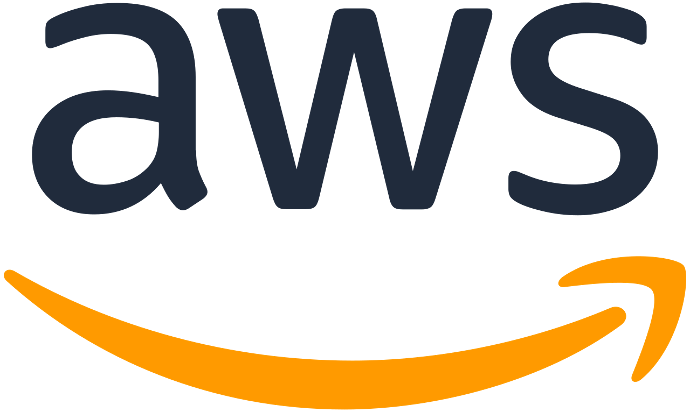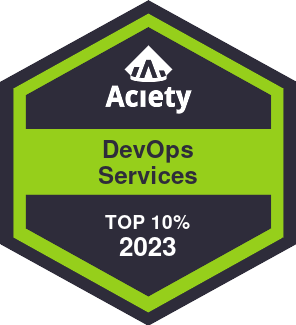DevOps як послуга
DevOps-as-a-Service (DaaS) дозволяє вам скористатися перевагами делегування всіх супутніх завдань, управління та обслуговування системи професійній DevOps-компанії та її інженерам, таким чином, відкриваючи можливість для розробників зосередитися на вдосконаленні продукту та впровадженні нових функцій.
Сертифікати та досягнення команди
Наші співробітники мають підтверджену експертизу в найрізноманітніших технологіях.






Як це працює
Планування і вимірювання
Ми є провідною фірмою, що забезпечує якість та цінність. Наші фахівці мають більш ніж 5-річний досвід роботи у сфері
Розробка та тестування
Наші менеджери завжди готові відповісти на ваші запитання. Ви можете телефонувати нам у вихідні та вночі.
Випуск та розгортання
Наша компанія працює за принципом індивідуального підходу до кожного клієнта.
Моніторинг та оптимізація
Ми аналізуємо ваші поточні системи моніторингу та рекомендуємо зміни і впровадження найкращих практик, щоб ви одразу знали, що не так, і мали інформацію, необхідну для їх виправлення.
Що ми пропонуємо
Ми підтримуємо наших клієнтів за такими основними принципами, але не обмежуючись ними
Dev Ops Підтримка
Оцінка та аудит DevOps Впровадження DevOps з нуля - дорожня карта та розробка стратегії DevOps-консалтинг Управління релізами
Хмарні сервіси
Оцінка готовності хмари Хмарна міграція Керовані хмарні сервіси
Проектування архітектури інфраструктури
Проектування архітектури мікросервісів Консультації з мікросервісів. Дизайн мережі доставки контенту (CDN)
Безпека
Автоматизація інфраструктури Інфраструктура як реалізація коду в хмарі Інфраструктура як локальна реалізація коду
CI/CD
Реалізація безперервної інтеграції (CI). Реалізація безперервної доставки (CD). CI/CD консалтинг
Створення інфраструктури як коду (IAAC)
Автоматизація інфраструктури Інфраструктура як реалізація коду в хмарі Інфраструктура як локальна реалізація коду
Оркестровка контейнера
Оркестровка контейнера Послуги з управління контейнерами Оцінка та зміцнення безпеки Керовані служби Kubernetes
Керування журналами та моніторинг
Управління журналом Моніторинг. Звітність Сповіщення
Про Dev Ops сервіси
Проектування архітектури хмарної інфраструктури - це процес планування та реалізації інфраструктури для середовища хмарних обчислень. Сюди входить проектування апаратного та програмного забезпечення, мереж та інших компонентів, необхідних для підтримки розгортання та роботи додатків і сервісів у хмарі.
При проектуванні архітектури хмарної інфраструктури важливо враховувати такі фактори, як бажаний рівень масштабованості, продуктивності, безпеки та економічної ефективності, а також специфічні вимоги додатків і сервісів, що розгортаються в хмарі.
Процес проектування зазвичай включає вибір відповідної моделі хмарних обчислень (наприклад, публічної, приватної або гібридної хмари), а також базових компонентів інфраструктури та технологій, які будуть використовуватися (наприклад, віртуальні машини, контейнери, системи зберігання даних та мережеві конфігурації).
Існують різні інструменти та засоби, які можуть бути використані для підтримки процесу проектування архітектури хмарної інфраструктури, в тому числі:
● Фреймворки хмарної архітектури: Вони надають набір рекомендацій та найкращих практик для проектування та впровадження архітектур хмарної інфраструктури. Приклади включають AWS Well-Architected Framework та Cloud Native Computing Foundation (CNCF) Cloud Native Landscape.
● Інструменти автоматизації хмарної інфраструктури: Уможливлюють автоматичне забезпечення та управління ресурсами хмарної інфраструктури, такими як віртуальні машини, системи зберігання даних та мережеві конфігурації. Приклади включають Terraform, CloudFormation та Ansible.
● Інструменти моніторингу та управління хмарною інфраструктурою: Дозволяють організаціям контролювати продуктивність і доступність ресурсів хмарної інфраструктури та керувати ними. Приклади включають CloudWatch, New Relic та Datadog.
● Інструменти хмарної безпеки: Вони допомагають організаціям убезпечити свою хмарну інфраструктуру та захиститися від таких загроз, як витік даних і кібератаки. Приклади включають CloudTrail, CloudHSM та AWS Shield.
Управління інфраструктурою стосується процесу планування, організації та контролю роботи та обслуговування інфраструктури організації. Це включає апаратне забезпечення, програмне забезпечення, мережеві та інші компоненти, які підтримують розгортання та роботу програм і служб.
Існують різні інструменти та засоби, які можна використовувати для підтримки управління інфраструктурою, в т.ч:
● Інструменти керування конфігурацією: вони дозволяють організаціям автоматизувати процес розгортання, налаштування та керування ресурсами інфраструктури. Приклади включають Ansible, Terraform, Helm
● Інструменти моніторингу та управління: вони дозволяють організаціям контролювати продуктивність і доступність ресурсів своєї інфраструктури та вживати коригувальні дії, якщо це необхідно. Приклади включають CloudWatch, New Relic і Datadog.
● Інструменти служби підтримки та управління інцидентами: вони дозволяють організаціям керувати і відстежувати інциденти та проблеми, що виникають у їхній інфраструктурі, а також своєчасно та ефективно вирішувати їх. Приклади включають ServiceNow або PagerDuty.
● Інструменти керування змінами: вони дозволяють організаціям відстежувати та контролювати зміни у своїй інфраструктурі, гарантуючи, що вони впроваджуються в контрольований та послідовний спосіб. Приклади включають JIRA та ServiceNow.
Операційне управління відноситься до процесу управління повсякденною діяльністю та процесами, які необхідні для ефективного функціонування організації. Це включає такі дії, як планування та планування роботи, координація ресурсів, моніторинг ефективності та контроль витрат.
Існують різні інструменти та інструменти, які можуть бути використані для підтримки оперативного управління, в т.ч:
● Інструменти управління проектами: вони дозволяють організаціям планувати, відстежувати та керувати проектами, зокрема встановлювати цілі, визначати завдання та розподіляти ресурси. Приклади включають Jira, Trello та Microsoft Project.
● Інструменти для співпраці та спілкування: вони дозволяють командам ефективно спілкуватися та співпрацювати незалежно від місця розташування. Приклади включають Slack, Microsoft Teams і Zoom.
● Інструменти планування та планування ресурсів: вони допомагають організаціям планувати та планувати використання таких ресурсів, як персонал, обладнання та приміщення. Приклади включають Календар Google, MS Outlook.
● Інструменти моніторингу та управління ефективністю: вони дозволяють організаціям відстежувати та контролювати результативність своїх операцій, а також визначати сфери для покращення. Приклади включають Datadog, New Relic і CloudWatch.
Моніторинг інфраструктури стосується процесу постійного моніторингу продуктивності та доступності інфраструктури організації. Це включає апаратне забезпечення, програмне забезпечення, мережеві та інші компоненти, які підтримують розгортання та роботу програм і служб.
Існують різні інструменти та засоби, які можна використовувати для підтримки моніторингу інфраструктури, в т.ч:
● Інструменти моніторингу мережі: вони дозволяють організаціям контролювати продуктивність і доступність своєї мережевої інфраструктури, включаючи маршрутизатори, комутатори та інші мережеві пристрої. Приклади включають Nagios і Zabbix.
● Інструменти моніторингу серверів: вони дають змогу організаціям відстежувати продуктивність і доступність своїх серверів, включаючи використання ЦП, використання пам’яті та дискового простору. Приклади включають Datadog, New Relic і CloudWatch
.
● Інструменти моніторингу продуктивності додатків (APM): вони допомагають організаціям відстежувати продуктивність своїх додатків, включаючи час відповіді, рівень помилок та інші показники. Приклади включають New Relic, AppDynamics і Dynatrace.
● Інструменти моніторингу сховища: вони дозволяють організаціям відстежувати продуктивність і доступність своїх систем зберігання, включаючи дисковий простір, продуктивність введення/виведення та інші показники. Приклади включають CloudWatch, Datadog і Splunk.
● Інструменти моніторингу бази даних: вони дозволяють організаціям відстежувати продуктивність і доступність своїх баз даних, включаючи час відповіді на запити, використання ЦП та інші показники. Приклади включають Datadog, New Relic і CloudWatch.
Управління інцидентами стосується процесу виявлення, сортування та вирішення інцидентів, які виникають в інфраструктурі організації. Інцидент — це подія, яка порушує або загрожує порушити нормальну роботу інфраструктури.
Існують різні інструменти та інструменти, які можна використовувати для підтримки управління інцидентами, в тому числі:
● Програмне забезпечення для керування інцидентами: воно дозволяє організаціям відстежувати інциденти та керувати ними, зокрема призначати завдання, установлювати пріоритети та відстежувати прогрес. Приклади включають ServiceNow і JIRA.
● Інструменти моніторингу та оповіщення: вони дозволяють організаціям виявляти і сповіщати про інциденти, щойно вони відбуваються, дозволяючи їм швидко реагувати та мінімізувати вплив. Приклади включають CloudWatch, Datadog і New Relic.
● Інструменти аналізу першопричин: вони допомагають організаціям визначити основну причину інцидентів, щоб вони могли вжити заходів для запобігання подібним інцидентам у майбутньому. Приклади включають PagerDuty і AppDynamics.
● Інструменти для співпраці та спілкування: вони дозволяють командам ефективно спілкуватися та співпрацювати незалежно від місця розташування. Приклади включають Slack, Microsoft Teams і Zoom.
● Інструменти управління знаннями: вони дозволяють організаціям отримувати та ділитися знаннями про вирішення інцидентів і найкращі практики, щоб вони могли з часом покращувати свої процеси управління інцидентами. Приклади включають Confluence і SharePoint
Управління потужністю – це процес планування, координації та контролю за використанням ресурсів організації, включаючи апаратне забезпечення, програмне забезпечення, мережу та інші компоненти, щоб гарантувати, що вони відповідають поточним і майбутніми потребами підприємства.
Існують різні інструменти та засоби, які можна використовувати для підтримки управління потужністю, зокрема:
● Інструменти планування потужностей: вони дозволяють організаціям прогнозувати та планувати майбутні потреби в потужностях на основі таких факторів, як очікуване зростання, моделі робочого навантаження та використання ресурсів. Приклади включають HPE Capacity Planner і SolarWinds.
● Інструменти планування та планування ресурсів: вони допомагають організаціям планувати та планувати використання таких ресурсів, як персонал, обладнання та приміщення. Приклади включають Календар Google, Asana та Resource Guru.
● Інструменти моніторингу та управління ефективністю: вони дозволяють організаціям відстежувати та контролювати продуктивність своєї інфраструктури та визначати сфери, які потрібно покращити. Приклади включають Datadog, New Relic і CloudWatch.
● Інструменти прогнозування використання ресурсів і потужностей: вони допомагають організаціям прогнозувати використання ресурсів і потреби в потужностях на основі історичних даних і тенденцій. Приклади включають BigQuery Google Cloud і автоматичне масштабування Amazon Web Services (AWS).
Впровадження процесу відноситься до процесу запровадження та впровадження нового процесу або процедури в організації. це може включати розробку процесу, донесення деталей до зацікавлених сторін, навчання працівників та інтеграцію процесу в існуючі системи та процедури організації
Впровадження процесу часто є важливою частиною управління організаційними змінами, оскільки воно допомагає гарантувати плавне та ефективне впровадження нових процесів без порушення існуючих операцій.
Існує кілька ключових етапів реалізації процесу, зокрема:
● Визначення процесу: це передбачає визначення мети процесу, задіяних кроків, а також необхідних ресурсів і вхідних даних.
● Комунікація процесу: це передбачає чітке повідомлення деталей процесу всім відповідним зацікавленим сторонам, включаючи співробітників, клієнтів та інших зацікавлених сторін.
● Навчання працівників: це передбачає надання працівникам знань і навичок, необхідних для ефективного виконання процесу.
● Тестування процесу: це передбачає проведення пробного запуску процесу, щоб переконатися, що він працює належним чином, і виявити будь-які проблеми або вдосконалення, які можуть знадобитися.
● Впровадження процесу: це передбачає інтеграцію процесу в існуючі системи та процедури організації та внесення будь-яких необхідних змін для забезпечення його безперебійної роботи.
Управління доступністю в хмарних розробках стосується процесу забезпечення того, щоб програми та служби організації були доступними та доступними для користувачів у разі потреби. Це особливо важливо в середовищі хмарних обчислень, де доступ до програм і послуг часто здійснюється через Інтернет.
Існує кілька ключових міркувань щодо управління доступністю в хмарній розробці, зокрема:
● Доступність мережі: це стосується доступності мережевої інфраструктури, яка підтримує розгортання та роботу програм і служб у хмарі. Це включає маршрутизатори, комутатори та інші мережеві пристрої, а також саме підключення до Інтернету.
● Доступність системи: це відноситься до доступності апаратних і програмних систем, які підтримують розгортання та роботу програм і служб у хмарі. Це включає сервери, системи зберігання даних та інші компоненти інфраструктури.
● Доступність даних: доступність і доступність даних, які використовуються програмами та службами в хмарі. Це включає дані, що зберігаються в базах даних, системах зберігання об’єктів та інших системах зберігання.
Щоб забезпечити доступність хмарної розробки, організаціям може знадобитися впровадити ряд заходів, наприклад:
● Надлишковість і відновлення після збоїв: це передбачає впровадження надлишкових компонентів інфраструктури та систем, щоб у разі збою одного компонента інший міг взяти на себе роботу.
● Балансування навантаження: це передбачає розподіл вхідного трафіку між декількома серверами або компонентами інфраструктури, щоб гарантувати рівномірний розподіл навантаження та збереження доступності додатків і служб.
● Моніторинг і попередження: це передбачає безперервний моніторинг продуктивності та доступності програм і служб, а також попередження про будь-які проблеми або збої, які можуть виникнути.
● Аварійне відновлення: передбачає впровадження плану відновлення додатків і служб у разі аварії чи значного збою.
Управління випусками — це процес координації, планування та контролю за розгортанням нових версій програмного забезпечення та інших програм і послуг. Це передбачає тестування та перевірку функціональності та стабільності нових випусків, а також координацію розгортання випусків у виробничих середовищах.
Існують різні інструменти та засоби, які можна використовувати для підтримки управління випусками, в тому числі:
● Системи контролю версій: вони дозволяють організаціям відстежувати та керувати змінами програмного коду та інших активів, а також співпрацювати з членами команди над проектами розробки. Приклади включають Git.
● Інструменти безперервної інтеграції/безперервного розгортання (CI/CD):
Це дозволяє організаціям автоматизувати процес створення, тестування та розгортання змін коду, дозволяючи їм швидко та легко випускати нові функції та оновлення. Приклади включають Jenkins, GitLabCI, GitHub Actions, конвеєри Bitbucket, Azure DevOps і AWS CodePipeline.
● Інструменти керування тестуванням: вони допомагають організаціям планувати, координувати та відстежувати заходи тестування, включаючи функціональне тестування, регресійне тестування та тестування ефективності. Приклади включають TestRail.
● Програмне забезпечення для керування випусками: вони дозволяють організаціям відстежувати процес випуску та керувати ним, включаючи планування випусків, координацію дій із розгортання та відстеження прогресу. Приклади включають JIRA та ServiceNow
.
● Інструменти автоматизації розгортання: вони дозволяють організаціям автоматизувати процес розгортання нових версій у виробництві.
Управління безпекою в хмарі означає процес забезпечення безпеки та цілісності програм, даних та інфраструктури в середовищі хмарних обчислень. Це включає захист від таких загроз, як витік даних, кібератаки та неавторизований доступ.
Існують різні інструменти та засоби, які можна використовувати для підтримки керування безпекою в хмарі, зокрема:
● Інструменти керування ідентифікацією та доступом (IAM): вони дозволяють організаціям керувати доступом користувачів до хмарних ресурсів, включаючи автентифікацію, авторизацію та керування доступом на основі ролей. Приклади включають AWS IAM і Google Cloud Identity.
● Інструменти захисту даних: вони допомагають організаціям захистити конфіденційність, цілісність і доступність даних, що зберігаються в хмарі. Це може включати інструменти шифрування, рішення для резервного копіювання та відновлення, а також інструменти планування аварійного відновлення. Приклади включають AWS KMS і службу керування хмарними ключами Google Cloud.
● Інструменти безпеки мережі: вони дозволяють організаціям захищати мережеву інфраструктуру, яка підтримує розгортання та роботу програм і служб у хмарі. Це може включати брандмауери, системи виявлення та запобігання вторгненням та інші засоби контролю безпеки. Приклади включають AWS Security Hub, CloudFlare та Cloud Armor Google Cloud.
● Інструменти відповідності: вони допомагають організаціям гарантувати, що їх розгортання хмари та операції відповідають відповідним законам, нормам і галузевим стандартам. Це може включати інструменти для керування даними, конфіденційності даних і збереження даних. Приклади включають Центр відповідності AWS і Центр відповідності та безпеки Google Cloud.
● Інструменти управління інформацією про безпеку та подіями (SIEM): вони дозволяють організаціям відстежувати та аналізувати події та дані, пов’язані з безпекою, а також виявляти й реагувати на потенційні загрози в режимі реального часу. Приклади включають Splunk і LogRhythm.
Оптимізація витрат у хмарі означає процес мінімізації витрат на використання ресурсів хмарних обчислень, водночас задовольняючи бізнес і технічні потреби організації. Це може включати пошук способів зниження вартості хмарної інфраструктури, оптимізацію використання ресурсів і використання функцій і послуг, що пропонують постачальники хмарних послуг.
Існують різні інструменти та інструменти, які можна використовувати для підтримки оптимізації витрат у хмарі, зокрема:
● Інструменти управління витратами та оптимізації: вони дозволяють організаціям відстежувати та контролювати свої хмарні витрати, визначати області для оптимізації витрат і впроваджувати заходи для економії. Приклади включають AWS Cost Explorer, Google Cloud Cost Management і Cloudability.
● Інструменти оптимізації ресурсів: вони допомагають організаціям оптимізувати використання своїх хмарних ресурсів за допомогою таких методів, як консолідація, віртуалізація та об’єднання ресурсів. Приклади включають VMware vSphere і Microsoft Hyper-V.
● Інструменти автоматичного масштабування: вони дозволяють організаціям автоматично збільшувати або зменшувати свої хмарні ресурси залежно від попиту, допомагаючи оптимізувати витрати та продуктивність. Приклади включають автоматичне масштабування AWS і автомасштабування Google Cloud.
● Точкові екземпляри: вони дозволяють організаціям робити ставки на резервну обчислювальну потужність, надаючи можливість заощадити до 90% витрат на хмарну інфраструктуру. AWS і Google Cloud пропонують точкові екземпляри.
●Позначення ресурсів: це передбачає призначення тегів хмарним ресурсам, що може допомогти організаціям відстежувати та розподіляти витрати, а також визначати ресурси, які використовуються неефективно. AWS і Google Cloud підтримують тегування ресурсів.
Ми допомагаємо нашим корпоративним клієнтам досягти їхніх бізнес-цілей, підтримуючи створення гнучкої архітектури та розробляючи споживчі точки дотику для все більшої кількості складних випадків використання
Ми можемо зробити більше ніж ви очікуєте
Будемо на зв'язку

